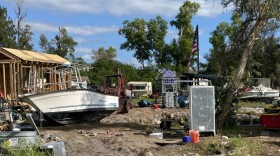The James Webb Space Telescope, on a long and winding journey to its job site a million miles from Earth, has begun the key task of unfurling a giant umbrella-like shield to protect its delicate instruments from the intense radiation of the sun.
The deployment of the shade — one of numerous maneuvers that must be performed flawlessly for the $10 billion telescope to function properly — began Tuesday with the successful lowering of two arms known as Unitized Pallet Structures.
They house five ultrathin membranes made of a shiny material called Kapton packed inside, along with the cables and pulleys needed to fully deploy. NASA expects the slow and deliberate process of unfolding the tennis-court-sized shield to continue at least through the weekend.
The mission operations team completed the approximately four-hour process of lowering the forward pallet and latching it into place by early Tuesday afternoon, finishing the deployment of the aft pallet by evening.
The long-delayed telescope, launched on Christmas Day, is the successor to the highly successful but aging Hubble Space Telescope. Webb's capability is expected to far surpass the famous Hubble: The new scope's much larger primary mirror gives it more than six times the light-gathering area than Hubble had.
Ultimately, Webb will be about 100 times as powerful as the older Earth-orbiting observatory. That means it will be able to spy much fainter and much farther space objects. Webb is also tuned to see in the infrared part of the spectrum, giving it the ability to see objects that were largely hidden to Hubble.
Light travels incredibly fast, but it still takes time to travel from a star or other source to our telescopes. The farther a source is, the longer it takes for its light to reach us. This means all telescopes view objects not as they are, but as they once were — in some cases millions or even billions of years ago. Because of Webb's sensitivity, it will be able to see all the way back to a time when the first galaxies were forming after the Big Bang, which took place about 13.8 billion years ago.
The successful deployment of the sunshield will keep the temperature of its instruments just above absolute zero, which in turn will minimize infrared background "noise" in the form of heat from the sun.

The sunshield maneuver is being performed as Webb speeds toward a spot known as L2, which is beyond the orbit of the moon where gravitational influences are in balance, providing a stable observing post. That journey will take about a month.
The next step major step after deploying Webb's sun shade is unfolding the telescope's primary mirror — assembled from 18 smaller gold-coated hexagonal mirrors made of beryllium. Once fully aligned, they will stretch 256 inches, or more than 21 feet, across.
For comparison, the Hale Telescope at Palomar Mountain in Calif., reigned supreme as the largest such instrument in the world for some 45 years after its 1948 completion. Hale's primary mirror measured 200 inches.
Copyright 2021 NPR. To see more, visit https://www.npr.org.









